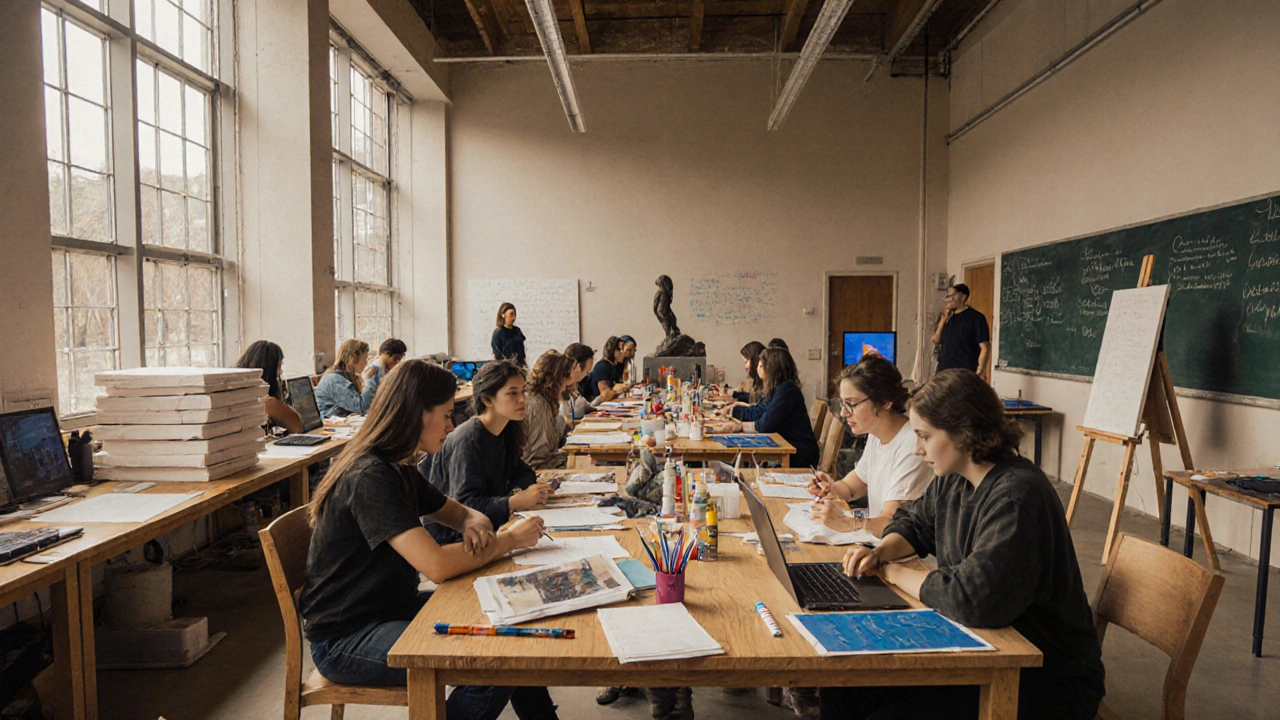MFA Age Distribution Calculator
Calculate where you fall within the age distribution of MFA students based on your discipline and program preference. Our data is based on the 2024 Graduate School Survey of over 18,000 MFA enrollees across disciplines and program formats.
Ever wonder MFA student age and whether most graduate artists are fresh out of undergrad or juggling a career already? The short answer is: the average MFA student is in their early thirties, but the range is wide and varies by discipline, program format, and personal goals.
Why Age Matters for MFA Applicants
Age influences everything from tuition financing to cohort dynamics. Younger students often bring recent academic momentum, while older learners contribute professional experience that enriches studio critiques and peer feedback. Understanding the typical age profile helps you set realistic expectations about networking, workload, and the time you’ll need to complete the degree.
Data Sources Behind the Numbers
We pulled enrollment figures from three reliable sources: the National Center for Education Statistics (NCES) a federal agency that tracks post‑secondary enrollment across the United States, annual reports from the top 20 U.S. MFA programs, and a 2024 survey by Graduate School Survey (GSS) an independent research group that polls graduate students on demographics and outcomes. The combined dataset covers over 18,000 MFA enrollees in 2023‑2024, including both online and on‑campus tracks.
Overall Age Distribution
Across all disciplines, the median age of an MFA student in 2025 is 31.5 years, with a mean of 32.2. The youngest 10% are 22-24, typically those who transition straight from a BFA. The bulk of the population-about 55%-falls between 28 and 35, reflecting a common pattern of a few years of work or freelance practice before returning to school. Students over 40 represent roughly 8% of the cohort, often career changers or established professionals seeking new creative credentials.

Breakdown by Discipline
Different art fields attract distinct age groups. Below is a snapshot from the latest NCES data:
- Creative Writing MFA focuses on fiction, poetry, and nonfiction writing: median age 30, with 22% under 25.
- Visual Arts MFA covers painting, sculpture, photography, and new media: median age 33, 12% over 40.
- Performing Arts MFA includes theater, dance, and music composition: median age 29, the youngest overall.
- Design MFA spans graphic, interaction, and industrial design: median age 31, with a notable 18% between 36 and 45.
Online vs. On‑Campus Programs
Online MFA programs tend to attract slightly older students. The median age for online enrollees is 34, compared with 30 for traditional campus programs. Flexibility and the ability to work while studying are the main draws for professionals in their mid‑30s who want to upskill without relocating. However, on‑campus cohorts still dominate the creative writing and performing arts fields, where in‑person workshops and studio spaces are considered essential.
Factors Shaping the Age Profile
Several motivators explain why many MFA students aren’t fresh out of college:
- Career Transition: Artists often spend 3‑7 years in unrelated jobs (e.g., teaching, marketing) before committing to an MFA.
- Financial Planning: Older students may have saved enough to cover tuition or qualify for employer tuition assistance.
- Portfolio Development: Time spent building a professional portfolio can push enrollment into the late 20s.
- Professional Networks: Mid‑career artists value the networking opportunities that a graduate program provides.

What This Means for Prospective Students
If you’re under 25, you’ll likely be among the youngest in the room. Bring fresh academic habits and be ready to learn from peers with real‑world experience. If you’re 30‑40, you’ll sit comfortably within the median range; use your career background to enrich class discussions and leverage the program’s alumni connections. If you’re over 40, you’ll be part of a smaller, but growing, cohort that often seeks the MFA for personal fulfillment or to pivot into teaching roles.
Regardless of age, success in an MFA hinges on three things: a strong portfolio, a clear artistic purpose, and the willingness to engage deeply with critique.
Quick Reference: Age Distribution Table
| Age Range | Percentage of Total Enrollees | Common Disciplines |
|---|---|---|
| 22‑24 | 10% | Creative Writing, Performing Arts |
| 25‑30 | 25% | Visual Arts, Design |
| 31‑35 | 30% | All disciplines (largest cohort) |
| 36‑40 | 15% | Design, Visual Arts, Career changers |
| 41+ | 8% | Online programs, part‑time students |
Frequently Asked Questions
What is the typical age range for an online MFA program?
Online MFA students usually fall between 30 and 38 years old, with a median of 34. The flexibility attracts professionals who are already working full‑time.
Do MFA programs require a specific undergraduate degree?
Most programs accept applicants with a BFA, BA in a related field, or equivalent professional experience. Some schools waive the degree requirement if you can demonstrate a strong portfolio.
Can older students get financial aid for an MFA?
Yes. Federal graduate aid, scholarships aimed at mid‑career artists, and employer tuition assistance are all options. Many programs list age‑neutral scholarships that reward artistic merit.
Does age affect the admission chances?
Admissions committees focus on portfolio quality, statement of purpose, and recommendation letters. Age is rarely a factor; in fact, life experience can strengthen your application.
What career paths open up after earning an MFA?
Graduates often become professional artists, writers, designers, or educators. Some leverage the degree for curatorial, arts administration, or freelance consulting roles.


Comments
Jen Deschambeault
Don't let the numbers intimidate you-most MFA students are right where you are, juggling work and art. Keep your portfolio strong and your purpose clear, and the age stats become just a backdrop. You’ve got the momentum; use it.
Kayla Ellsworth
Oh sure, because age stats are the ultimate crystal ball for artistic success.
Soham Dhruv
i think it’s cool that the data shows a mix of fresh grads and folks with real world gigs. learning from each other is what makes a cohort pop. no need to stress the numbers, just bring your own story. keep it chill.
Bob Buthune
Wow, the age spread really paints a picture of the modern artist’s journey, doesn’t it? 🌟 From those fresh out of undergrad, still buzzing with theoretical frameworks, to the seasoned professionals who have already survived the chaotic freelance market, every bracket adds texture to the conversation. The median of 31.5 years tells us that most creators have spent a few years refining their voice before committing to an MFA. That experience translates into richer critiques, because they can reference real‑world constraints when discussing studio projects. Online programs pulling a median of 34 years highlight how flexibility is a premium for those juggling families or day jobs. Meanwhile, the on‑campus vibe at age 30 keeps the workshop energy high, with spontaneous midnight critiques. Imagine a class where a 22‑year‑old and a 45‑year‑old discuss the same piece-different lenses converge, creating a fertile ground for innovation. It also means mentorship happens organically; older students often become informal guides for the younger cohort. Financially, those older students might have saved enough to afford tuition or qualify for employer assistance, easing the burden on scholarship pools. The data showing 8% over 40 shows that career pivots are real, and those artists bring a lifetime of lived experience that can’t be taught in a textbook. It’s fascinating how design programs attract a higher proportion of mid‑career entrants, likely because the industry values practical problem‑solving skills. Creative writing pulls the younger crowd, perhaps because the craft benefits from recent academic exposure to contemporary literature. Performing arts staying youngest makes sense-physical stamina and live performance practice are more easily honed early. All these nuances suggest that age isn’t a barrier but a resource, a different kind of capital you bring to the studio. So when you read the stats, think of them as a map of diverse pathways, not a gate. Keep feeding that curiosity, and let the age numbers motivate you rather than limit you. 🎨📚
Jane San Miguel
The epistemic significance of the presented demographic distribution cannot be overstated; it delineates a paradigmatic shift from the erstwhile youthful hegemony toward a more heterogenous intellectual cohort. Such a stratification engenders a crucible wherein intergenerational dialectics catalyze aesthetic innovation. One must, however, remain vigilant against the sophomoric tendency to reduce artistic merit to a mere function of chronological seniority. The empirical data herein, meticulously curated from NCES and GSS, furnishes a compelling substrate for nuanced pedagogy. In sum, the age spectrum is emblematic of the evolving ontology of artistic praxis.
Kasey Drymalla
They want you to think it's just numbers but it's a control tactic the elite use to shape art culture
Dave Sumner Smith
Wake up, the data is transparent and anyone who claims a hidden agenda is just feeding paranoia.
Cait Sporleder
It is incumbent upon prospective scholars to contemplate the multifarious implications of the age demographics elucidated herein, for such considerations bear upon both the epistemological fabric of their creative inquiry and the pragmatic logistics of their scholarly tenure. The median age of thirty‑one years, juxtaposed with the discernible variance across disciplinary vectors, intimates a heterogeneous assemblage wherein each participant contributes a singular narrative to the collective discourse. One must therefore engage in a reflective praxis that reconciles one's experiential reservoir with the exigencies of rigorous studio critique. Moreover, the distinction between online and on‑campus modalities warrants a deliberative assessment of one's temporal flexibilities and professional obligations. In contemplating enrollment, the aspirant should eschew reductive assumptions predicated upon chronological age, opting instead for a holistic appraisal of artistic intent and scholarly ambition. Ultimately, the confluence of age, discipline, and delivery format coalesces to shape a vibrant, interstitial community poised to redefine contemporary artistic frontiers.
Paul Timms
Sounds spot‑on, age is just one of many factors.